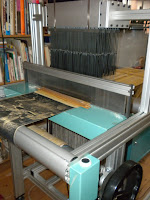 This weave is on the 'tjoekenbak' it is a ornamented plainweave in thin cotton yarn taken double in warp and weft.
This weave is on the 'tjoekenbak' it is a ornamented plainweave in thin cotton yarn taken double in warp and weft.
This is a woven picture of my son skating, made on the TC1 with th Arahweave software. It is a silk warp and weft.
This work in progress:

A plain double weave treated in blocks.
This work is 'the female' or spring. I made another in more brownish colors 'the male' or autumn .It is made on the replica with 8 shafts using cotoline.
Another work not finished is on the dobby loom. It is a network drafting twill with linnen / cotolinen warp and fine wool weft. I planning to dye it after it gets off the loom so that only the wool is dyed. Now it looks like this:

I'm not sure what color I will use...
The last loom is occupied with a 8 end straight treading in three blocks. But I'm getting bored after 1 meter weaving with fine cotton. I think I'm going to cut and retread it.

Note: The colors of the weavings seem duller then they are but they are muted.










